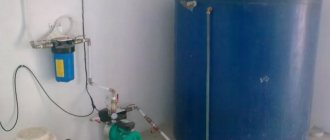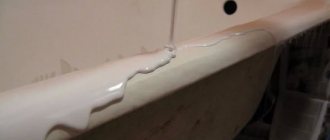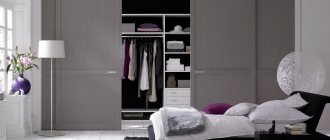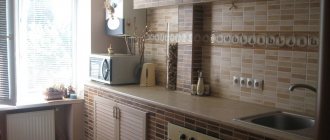Just recently, a hygienic shower in the toilet was a kind of exotic thing. Today it’s hard to surprise with the presence of such plumbing in an apartment. On the contrary, this indicates refinement of taste and the presence of rules of good manners in the house. In addition, using a shower in the toilet instead of a bidet is more convenient.
However, for the average person, such a hygiene item will still be quite new. And you can expect to receive high-quality advice about the nuances of the device and connection options in a plumbing store in rare cases. Therefore, familiarizing yourself with this material will be useful for people who have already decided on the choice of such a device and are just planning to purchase a shower for cleaning the toilet.
Option for a hygienic shower in the toilet Source trendkeramika.ru
What is the device intended for and its strengths
Before connecting a hygienic shower, you should decide whether it is needed at all. In most cases, apartment owners prefer to make do with ordinary bidets, and toilet paper remains the most common method of hygiene in the toilet.
Such a device will certainly be useful in eastern countries or areas where residents profess Islam predominate. It is well known that this religion is quite strict in matters of purity.
The main advantages of installing such a mixer:
- Better cleansing of intimate areas compared to toilet paper.
- A high level of sanitary and hygienic conditions in housing, thanks to the flushing of sewage directly into the toilet.
- There are no possible abrasions and irritations on the skin, as is the case with toilet paper, even the highest quality and most delicate types of which can cause uncomfortable sensations.
- The presence of such a device greatly facilitates household chores associated with cleanliness and sanitation. Using this hose with a nozzle, it is easier to clean the plumbing itself, the children's potty or the cat's litter box.
Hygienic shower as a housekeeping assistant Source amazonaws.com
- Research shows that regular use of a hygienic shower reduces the likelihood of hemorrhoids, proctitis, etc., thanks to the additional massage with a stream of water during the cleaning process.
The main advantage of the device remains its compactness. Its placement is possible in the toilet of any, even the smallest, apartment. The dimensions of such a shower are not much different from a toilet paper holder.
Types of faucets for hygienic showers
This element of a hygienic shower, according to its design, comes in three types - valve, lever and with a thermostat.
The first is more common and differs in that the water volume is controlled through a valve. It is installed when connecting a hygienic shower to a sanitary cabinet. Thus, it is inconvenient to manually regulate the water temperature; an additional thermostat connection will be required.
A lever mixer is more convenient to use. It works well without additional equipment, so installation is easier. The designers assigned the lever the role of regulating water pressure and temperature. It's easy to manage all this with its help.
The photo shows a single lever chrome faucet. When installing, do not connect a long hose to it. It will interfere with temperature regulation
To constantly maintain the optimal temperature and pressure of the water jet for a particular person or all residents of the apartment, a thermostat mixer is more suitable than others. Its operation is not affected by any pressure surges in the system. The disadvantage is the high cost of the device.
Design Features
The appearance of the hygienic device is practically no different from the well-known standard shower. Both of them consist of:
- mixer;
- flexible hose;
- watering cans.
But the purpose of the device still causes some differences. There is no need for a large, diffuse stream of water, so select a small-sized mixer with a focused, gentle flow without splashing.
Some models of such showers are equipped with a thermostat to automatically regulate the comfortable temperature of the water stream. Once the thermostat is adjusted immediately after installing the shower, it will ensure that the set temperature is maintained throughout its entire lifespan.
A type of hygienic shower for the toilet Source ozonsanteh.ru
This element will protect you from possible unpleasant sensations when coming into contact with too hot or cold water.
The main difference is that the water from the switched-on hygienic shower does not flow until a special flow control button is pressed, and the pressure is adjusted using a special mixer lever.
Useful tips
- Before “dirty” operations, it is necessary to isolate all surfaces that cannot be repaired. Several layers of thick oilcloth are suitable for tiles. Breaking the floor with a broken piece takes 5 seconds, but restoring the tiles is not always possible.
- Do not skimp on insulation films and check the quality of the connection as you go. Only if everything works perfectly can finishing work be carried out and the pipes covered with tiles.
- To prevent the tile from cracking due to the sharp entry of the drill, it is better to cover the drilling site with masking tape. This doesn’t always help, but you need to play it safe. Start with low speeds so as not to spoil the repair.
Do not drill into tiles with a hammer drill. Along with rotation, it produces reciprocating movements and simply breaks the surface. This is useful for scoring, but not for making a neat hole.
- It is recommended to install a small hatch “under the tile” for easy access to the insides of the shower. If a pipe bursts or cracks, water will flood the inside of the wall and destroy it.
- To make a high-quality joint, you will need a tile drill and a ceramic blade.
Possible device installation options
Installing a hygienic shower in the toilet has a number of advantages:
- ease of installation and versatility of installation;
- small design;
- versatility in use;
- low cost;
- comfort in use.
The design of the “hygienic shower” concept is possible in four different external and functional options.
In the form of a shower toilet
This equipment has a special design with nozzles built into the body, which are hidden under the rim when the bidet function is turned off. The control of the device is built into the drain tank, increasing its dimensions. This way you can adjust the power and temperature of the flow, but the direction of the jet does not change by adjustment.
Toilet combined with bidet Source vvannoi.ru
This type of plumbing fixture is produced in floor-mounted and wall-hung versions, can be mechanical or electronic, and is constantly being improved by manufacturers. Therefore, the functionality of the device directly depends on the manufacturer and cost.
In the form of a bidet lid for the toilet
A fairly compact and convenient option that can be easily mounted to an old toilet model. In essence, this is a standard toilet lid of a special design containing a fitting for water supply. The control of the device is built directly into the lid, as a rule, it is capable of heating water, drying and gently lowering the seat.
The weak point of the design is the external water supply using flexible hoses. Often this does not look very aesthetically pleasing.
There are even fully electronic bidet lid options from well-known brands. The functionality and comfort of such elite sanitary ware differs significantly from conventional models, as does the price.
Electronic bidet lid for toilet Source insales.ru
See also: Catalog of companies that specialize in the design and installation of engineering systems.
In the form of a shower mounted on the wall
Arranging a hygienic shower in this way is the most common and convenient. Installation is carried out directly to the pipeline, and the compact watering can is placed on a long flexible hose on the wall. This will require certain construction work.
According to the standard, the height of a hygienic shower from the floor should be 60-80 cm, and the length of the hose should be limited to 1.5 meters. It is not recommended that it touch the floor.
As a rule, this version of the mixer is not equipped with a thermostat. However, it will not be difficult for a competent plumber to install this unit directly near the water supply in an inaccessible place. This will not affect ease of use, because... It is enough to adjust the thermostat once and for the entire service life.
The installation height of the hygienic shower and the distance from the toilet should be set so that using the device does not require additional effort and acrobatic abilities.
Hygienic shower on the wall Source wixstatic.com
In the form of a shower connected to the sink
This option is suitable for combined bathrooms, where there is a sink located near the toilet. You will need to purchase a special mixer with three outlets.
In the case of a separate bathroom, it will be enough to install a small sink in the corner of the room.
If the sink is already standing, then this option will be the most profitable financially and the least labor-intensive. Adjusting the water temperature is also easy in manual mode and does not require additional costs.
Installing a small sink with a hygienic shower in the toilet Source kitchenremont.ru
Types of products
Today's market for hygienic shower models is represented by several options. Each of them has its own characteristics and application features. The water connection can be hidden in the wall, or located in a visible place. In this case, built-in models imply some kind of repair if the device breaks down.
The design of the device is simple and in order to use it, you just need to press the button located on the watering can, first opening the mixer valve.
If the watering can has a thermostat, then the temperature is set only once, and subsequently it remains the same as it was set. In this case, the shower system will remember the desired temperature and will output it every time the shower is turned on.
In order not to bother yourself with repairs, in the process of connecting water to the mixer, simply lay the necessary pipe by connecting it to the nearest plumbing fixture.
The holder and watering can in the wall-mounted device are connected by a flexible hose.
Hygienic shower with sink. If the bathroom requires a sink next to the toilet, then you need to choose a faucet equipped with a third water outlet. Then, if necessary, water will be supplied to the shower head. This device works like this: when the tap is opened, water is supplied to the nose of the mixer and held there until the control button is pressed. As soon as the button is pressed, the water flows to the hygienic shower head. This shower model will fit perfectly into a small or combined bathroom. A variety of product options allows you to attach the shower head directly to the sink. And if the bathroom is very small, you should try choosing a sink with a corner placement, which is installed above the toilet cistern. This move will save additional space in the room.
Such devices are equipped with a built-in mixer, in which the control lever is mounted on top of the device or on the side
Installation of this type of hygienic shower is quite easy and is equivalent to installing a regular sink. The main design feature: a mixer with a third outlet. After using the tap, do not forget that it is necessary to turn off the mixer, otherwise water from it will flow into the sink.
Bidet toilet. This is a multifunctional device that in appearance resembles a standard toilet, but is equipped with a special nozzle for supplying water. The nozzle must be retractable and have a power button. It is usually located on the rim of the toilet. The water supply to the mixer in such devices is connected to the installation from below through a separate hose.
Such a universal device is good because it can be used both in regular toilets and in wall-hung ones, which significantly saves space in the bathroom. The design of the installation itself is a metal frame onto which the bowl is attached. By pressing the button on the toilet, the nozzle extends and supplies water at the desired temperature. At the end of use, the nozzle hides in its place. The pipes to this toilet-bidet are installed behind a false wall. The model is compact, but has a high cost, which depends on the set of additional functions and the manufacturer.
Bidet lid. Another option for a hygienic shower. Such a lid has a certain set of functions, which may include heating water to the desired temperature. The toilet lid is portable. It is equipped with control buttons that allow you to select one or another function. The lid itself is connected to the sink or to a tee, which is responsible for supplying water to the drain tank.
Bidet lids can be mechanical or electronic. The latter option is mains powered, is more expensive and may have additional features. However, in the absence of electricity, the possibility of using a bidet lid is reduced to zero, due to the fact that water heating will be carried out from the power supply.
The variety of models allows you to choose exactly the option that is most suitable for the bathroom with certain conditions.
Installation methods
Installation of a hygienic shower can be carried out in two ways - external and built-in.
Outer
The external method includes the above-described connection options to a conventional wall-mounted washbasin or bathtub faucet.
The advantages of this method will be the ability to install a mixer with a thermostat or simply adjust the temperature using the mixer lever above the sink. This is often much more convenient than controls installed above the toilet, on its lid or tank.
Built-in
This method involves hiding all communications and mechanisms behind the wall, bringing out only the platform with the lever. A mount for a watering can is also mounted outside. Sometimes it is already located on a common platform. Each option has a very aesthetic and presentable appearance.
Features of installing a hygiene device
If you need a spacious bathroom to install a bidet, then installing a hygienic shower in the toilet takes place without demolishing the walls and increasing the space of the room. It is mounted:
- on the wall of the room;
- into the toilet bowl lid;
- connected to the washbasin.
Any installation method is cheaper than purchasing a bidet and installing it. The hygienic device has several variations in its design, with their pros and cons, and installation features.
Video description
The process of installing a built-in hygienic shower can be viewed here:
This method is more problematic and has many disadvantages:
- the possibility of installation is not always possible and is determined by the presence of ventilation shafts, the thickness of the walls, etc.;
- control of water shutoff is difficult (if the water supply is not shut off, it can lead to a leak);
- there is a possibility of heated water mixing with cold water (this will affect not only the owner of the shower, the neighbors will also feel it). It is recommended to purchase a device containing a built-in check valve or install such a valve separately;
- there are no built-in models with thermostat adjustment on the platform (the temperature control device is usually adjusted once and hidden behind the wall);
- In the absence of a thermostat, the water temperature control is located above the toilet. This means you need to choose the right toilet model, which has an elongated bowl shape.
Flaws
If you are interested in a hygienic shower and a toilet shower, then before you start looking at the catalog of available models, read through all the disadvantages. Although this plumbing fixture is a convenient option, it does require dismantling some of the finishing when installing a hidden option. After this, you will need to start renovating the bathroom. In addition, to use it, you must have constant, good water pressure, i.e. pressure In separate bathrooms, it becomes necessary to purchase a thermostat.
Video description
The specifics and advantages of hygienic shower options can be seen in this video:
To summarize, a person will need to do:
- marking walls;
- gating;
- pipe laying;
- installation of communications, adapters, valves;
- facing works of new walls;
- connecting the mixer and hose;
- holder fastening;
- adjusting the thermostat, if equipped.
The lack of experience in carrying out at least one of these types of work suggests that it is better to contact a specialist with installation questions. Improperly carried out work can lead to a water breakthrough, flooding of neighbors, and, as a result, compensation for the damage caused.
Pros and cons compared to bidets
There is no need to argue about what is more convenient - a pair of toilet + bidet or a hygienic shower for the toilet. Everyone decides for themselves. Let's take a quick look at the main pros and cons of both devices:
- To install two bowls - a bidet and a toilet - more space is required. You can’t argue with this argument, although not everyone has a need to save space.
- When performing intimate hygiene procedures using a hose and watering can, you do not need to move from one plumbing fixture to another. Also an obvious fact.
- When using a shower, it is mounted somewhere on the wall. At the end of use, it may “drip” for some time - the remaining water will drain out. This is mainly a theoretical possibility, since in practice, with a properly functioning switch, there are no wet spots under the watering can.
No one is stopping you from putting all the options))
- When using a bidet, it is very difficult to forget to turn off the water. If you have a wall-mounted version of a hygienic shower, this is easy to do: there is a double shut-off system - a button/lever on the watering can and a tap on the mixer. The tap should not be left open after the procedure. In this case, the flexible hose is under constant pressure, but it is not designed for this, so it can break. The situation is different when using a faucet on a sink - you can see that water is flowing.
- A flexible hose can be used not only for its intended purpose, but also for other needs. For example, it is convenient to draw water, wash the toilet or cat/dog bowls and trays.
Oddly enough, it is the last fact that is often decisive - an additional bonus in the form of expanded functionality is always pleasant. Another advantage of showers is the possibility of organizing them for relatively little money. But this is about devices with a mixer.
Video description
Installing a hygienic shower in a toilet with polypropylene soldering:
First, you need to turn off the water supply and make pipe routing, preferably with the least number of turns.
If you have a thermostat, you should carefully approach the issue of connecting the water so as not to confuse the cold and hot pipes. The first is usually located on the right, and the second on the left. Then you should install pipes under the mixer, matching the distance with the holes of the mixer and thermostat.
After this, the wall is walled up and plastered, and then a hose with a mixer is connected. The nuts should be tightened as tightly as possible, but without over-tightening.
It is recommended to use anchor bolts to secure the holder to the wall. You should start by drilling holes for the dowel. A hole depth of 6 cm with a diameter of 6 mm will be sufficient. Then you need to insert the dowels and secure the clamp with anchors. The height of the hygienic shower from the floor should be as convenient as possible for its use by the shortest member of the family. This method is simple and reliable.
An example of placing a hygienic shower with size markings Source pinimg.com
After completing the installation, you should configure and check the operation of the hygienic shower. The pressure is turned on and the product is checked for leaks. A comfortable water temperature is checked and adjusted, and then its supply is shut off. It is recommended to turn off the water supply to the faucet after using the shower to reduce the effect of pressure on the control valve.
Installation of a shower for intimate hygiene
All four hygienic shower designs are installed according to their own scheme. For some models, construction intervention will be required before installing a hygienic shower in the toilet. The installation of others will not even damage the finishing of the walls; the wiring of the plumbing system is not affected.
Installation of a shower toilet
The process is identical to installing a regular toilet. Additionally, liquid is supplied and a mixer is installed.
The water supply pipeline is connected to the shower toilet in 3 ways:
- The cold liquid supply is connected to a ball valve, and later to a flexible hose.
- Pipes with hot and cold water are connected to a hidden mixer. Warm water comes out of the nozzles.
- Cold and hot water flows to the thermostat. It sets the temperature for serving.
The shower toilet comes in floor-mounted and wall-hung types. The second has a flush cistern mounted into the wall. Manufacturers have developed models equipped with a hairdryer, a heated seat, and spontaneous disinfection.
Bidet cover installation work
Schematically, the whole process is divided into 6 stages:
- The water supply stops and the remaining water drains from the cistern.
- The flexible hose for supplying water to the tank is removed.
- The old lid model is removed from the bowl. A tee is installed.
- A hose is connected to the tee.
- The new bidet lid is bolted to the bowl.
- The water supply opens.
This is an unusual cover and therefore its cost is high.
Installing a shower on a sink
Without the correct location of the washbasin, you will not be able to use the hygienic device comfortably. The sink is installed at such a distance that you can reach its edge while sitting.
This is explained by the peculiarity of the operation of the hygienic shower model: the tap on the washbasin bowl is opened, the temperature of the liquid supply is regulated. When a special button is pressed on the device, water stops flowing into the sink and pours through the watering can. If the button is released, water flows into the sink bowl.
Installation work boils down to replacing it with a mixer model with a separate outlet for a flexible hose with a watering can. Additionally, a holder for a watering can is installed on the wall.
Concealed wall mounting
Installation of the installation is carried out in a place close to communications. Most often they are hidden behind the toilet, in a niche. The connection to the water supply is made in this place, and the mixer itself is mounted nearby on the wall.
- Water supply pipes are laid in the grooves.
- The embedded part of the mixer is mounted in the wall.
- At the last step, the outer part of the mixer is attached to it.
The mixer is located in the niche, and the pipes are hidden in the grooves. When the connection is completed, the transformation of the wall and its cladding begins. The holder is later mounted in a place comfortable for use and the watering can is hung on it.
Open installation of hygienic shower on the wall with thermostat
Since the thermostat cannot be hidden in the wall, the hygienic shower with it is installed on the wall. The device is secured with dowels. Water is supplied through flexible hoses.
The water supply temperature is set once and maintained each time it is turned on. The model is recommended for installations where there is no hot water supply. The thermostat operates from the mains.
Installation of a hygienic shower on the wall without gating
If the room is not intended to be renovated in the near future, but there is a desire to install a hygienic device, then the option of mounting it on the wall without grooves is chosen.
- The water supply is laid along the walls.
- Closes with a decorative box.
- The box can play the role of a watering can holder or a holder is installed on it.
Video description
You can watch this video about whether you need a hygienic shower and what to look for when choosing one:
When choosing a device, you must pay attention to the material of manufacture. The ideal option would be chrome-plated brass or stainless steel with ceramic inside. Bronze products will be more expensive. But silumin ones are cheap, but not reliable. It is best to purchase products with a quality guarantee. Their selection is very large, and prices generally range from 1 to 15 thousand rubles.
Price
The German manufacturer Grohe sells high-quality bidets with hygienic showers at an affordable price. Another company from Germany, Hansgrohe, produces built-in models, which are highly expensive, but at the same time have a longer service life. Another good option is the Hong Kong company Bossini, which sells a hidden mixer and wall-mounted shower:
| Title | Price in rubles |
| Grohe BauFlow | 9800 |
| Cezares Olimp DIF 02 with mixer | 22622 |
| Bossini Nikita C69002 BR | 18259 |
| Hansgrohe | 2670 |
Manufacturers of the best showers for bathrooms
There are quite a lot of products for this purpose in stores and it is very difficult to figure out which one is better. Therefore, professionals recommend giving preference to products from world-famous companies. There are not so many such manufacturers. Based on user reviews and product popularity, the most popular brands are listed below:
- Hansgrohe;
- Damixa;
- Grohe;
- Geberit.
Hygienic shower set TM Grohe Source kaplya.com.ua
Products from these manufacturers will be guaranteed to be of high quality and comfortable, however, the cost of such faucets will be appropriate. But many experts are sure that saving in such a matter is inappropriate. Purchasing a cheaper and lower quality device, as a rule, leads to its faster breakdown and forced costs for its replacement and payment for related work. Therefore, the quality of the purchased plumbing fixtures should directly depend on the complexity of the installation work being carried out. It will be quite expensive to replace a leaky gasket or broken thread when the product is installed built-in.
In order not to become a victim of deception and not to purchase counterfeit goods, it is recommended to purchase plumbing fixtures in salons with a good reputation and with the obligatory presence of the necessary quality certificates for the products offered.
It must be remembered that high-quality products are not made from cheap materials, and their price will be appropriate.
Mixer for bidet with hygienic shower Source sanusel.ru
Advantages
Having decided that you need a toilet with a hygienic shower, keep in mind that any models of such sanitary products will look quite compact and modern, which is a big plus for a small toilet. Another advantage of such a device is that it is convenient to use for washing, especially since the supply of liquid, if you purchase a mixer, will be carried out from both cold and hot water supply systems. Other advantages of the equipment include:
- versatility in use;
- affordable price;
- ease of installation;
- Possibility of installation in almost any location.
Briefly about the main thing
A hygienic shower is one of the most convenient ways to carry out post-toilet procedures.
- Small in size. It can be placed even in the smallest closet without harming the free space.
- In addition to its direct purpose, it is often used for other household needs.
- The choice of a hygienic shower model is purely individual and depends on the size, layout and design of the toilet room.
- As with other plumbing equipment, it is recommended to purchase only high-quality certified products.
- It is recommended to entrust the installation of this plumbing fixture to a trained specialist, because... errors during installation can lead to big troubles for you and your neighbors. This is especially true for hidden devices.
Preparing for installation
Selecting location and installation height
You need to focus on height and body position in a sitting position. The arithmetic average of these two values will give the approximate height. How can you define it differently - install a sink and place objects under it until the position becomes comfortable for the reader.
Tools and materials
You will need:
- wrench;
- mount;
- hammer;
- sledgehammer;
- sealed film;
- roulette;
- drill;
- perforator;
- soldering iron;
- level.











